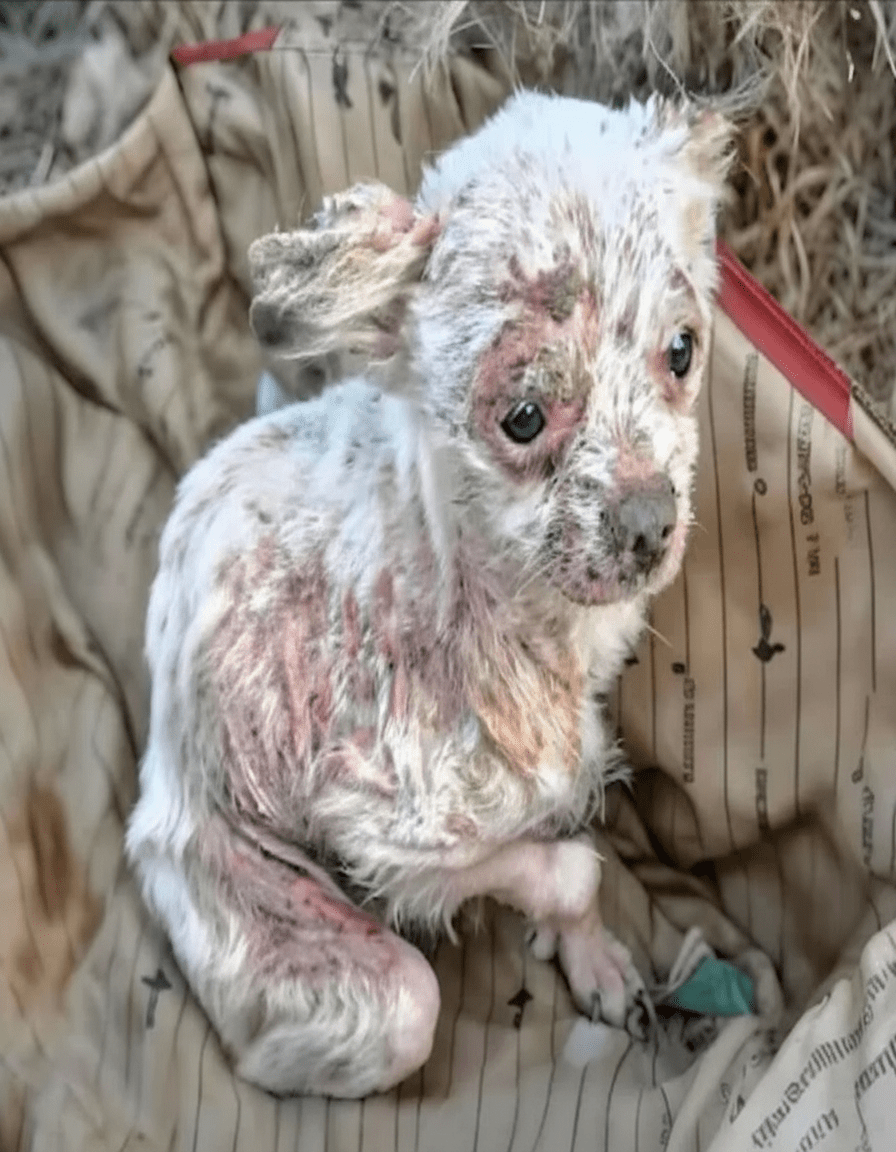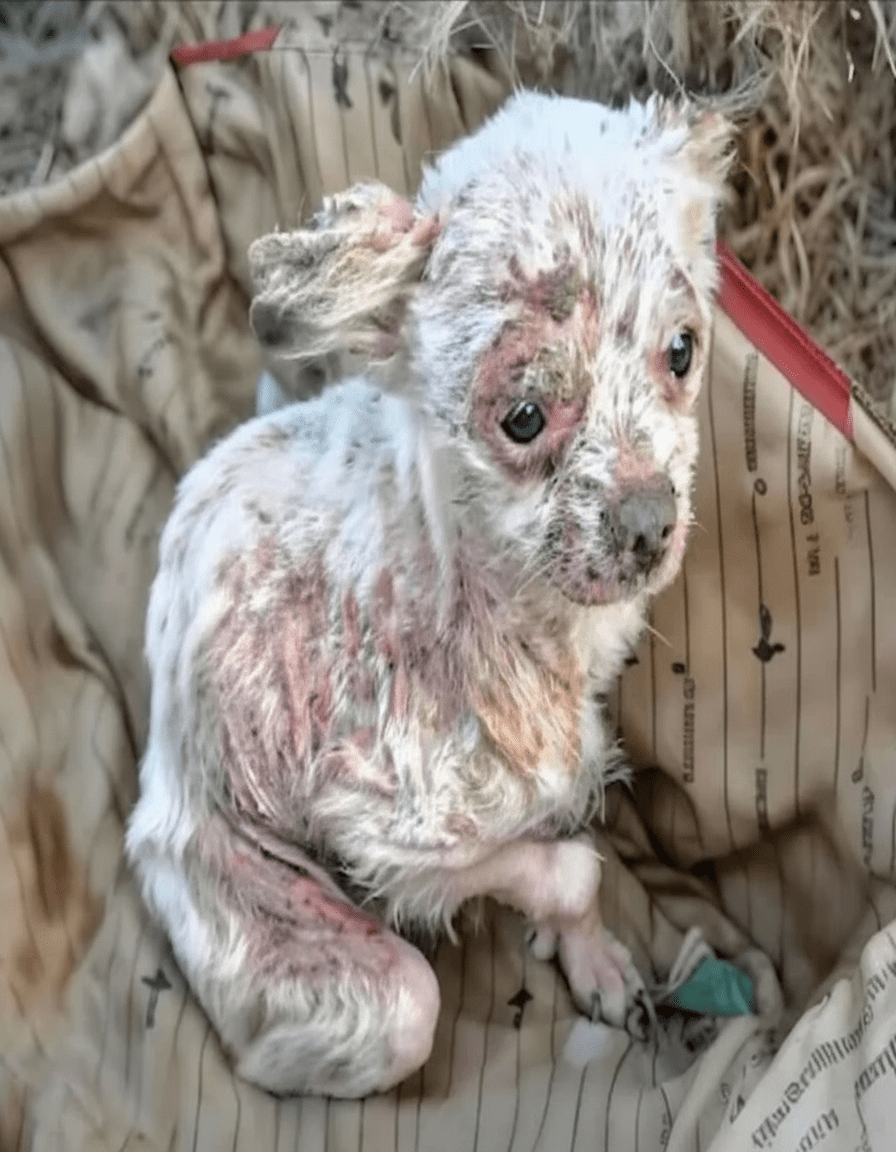In the dusty outskirts of a forgotten industrial yard on the fringes of Ho Chi Minh City, where rusted shipping containers loomed like silent sentinels and the air carried the faint sting of diesel and decay, a half-open suitcase lay abandoned beside a pile of broken pallets. It was late afternoon on a sweltering November day in 2023, and the suitcase—beige canvas streaked with travel stickers from places its owner would never return to—had been there for weeks, slowly filling with rainwater and debris. No one noticed when a tiny, trembling creature crawled inside, seeking shelter from the relentless sun. The puppy, barely the size of a man’s hand, was a living skeleton wrapped in patchy, inflamed skin. His ribs protruded like the ribs of the suitcase itself, and his eyes—cloudy with infection—peered out from beneath a crust of mange. He had no strength to bark, only to curl into the corner where a faded airline tag still fluttered, as if the suitcase itself were a portal to somewhere kinder. This was not just a dog in distress; this was a silent, desperate application for rescue, written in the language of survival.

The discovery came by sheer accident. Lan, a 28-year-old freelance photographer scouting locations for a documentary on urban decay, had wandered into the yard chasing the golden hour light. She was framing a shot of graffiti-splashed containers when something moved inside the suitcase. At first, she thought it was a rat. Then she saw the ears—two pink, translucent triangles twitching above a matted tuft of fur. Lan dropped to her knees, her camera forgotten. The puppy didn’t flinch when she reached in; he simply pressed his frail body against the fabric, as if trusting the suitcase to negotiate on his behalf. “I’ve seen stray dogs before,” Lan later recalled, “but this one looked like he’d already died and forgotten to lie down.”
She scooped him up in her scarf—afraid even her bare hands might bruise him—and rushed to the nearest vet clinic, a 40-minute motorbike ride through choking traffic. Dr. Minh, a gruff but compassionate veterinarian who’d treated everything from fighting roosters to circus elephants, took one look and shook his head. “Mange, malnutrition, secondary infections, possible heartworm,” he listed, his voice flat. “Realistically, euthanasia is the kindest option.” Lan refused. She named the puppy Vali—short for valise, the French word for suitcase—and paid for the first round of treatment with her own credit card. The bill was steep: antibiotics, medicated baths, deworming, and a special high-calorie formula that had to be syringe-fed every two hours. Vali weighed just 680 grams. A healthy puppy his age should have been triple that.
What followed was a rollercoaster no one could have scripted. The first twist came on day three, when Vali stopped breathing during a bath. His tiny heart fibrillated from the shock of warm water on raw skin. The clinic staff performed CPR with a cotton swab and a syringe bulb, reviving him after 42 agonizing seconds. Lan, who’d been sleeping on the clinic floor, sobbed into her helmet. But Vali’s eyes—now being treated with antibiotic ointment—opened wider, as if the near-death experience had burned away some of the haze. By day five, he took his first wobbly steps across the exam table, tail stump wagging like a metronome set to hope.

Then came the setback no one saw coming. Blood tests revealed canine parvovirus, a ruthless killer with a 90% mortality rate in unvaccinated puppies. The clinic didn’t have an isolation ward. Dr. Minh suggested putting Vali down again. Lan, sleepless and defiant, crowdsourced funds on a local pet rescue Facebook group. Within 24 hours, strangers had donated enough for a private isolation crate, IV fluids, and antiviral serum imported from Thailand. A retired nurse volunteered to monitor Vali overnight. The puppy’s survival became a communal vigil, with updates posted hourly: “He’s drinking Pedialyte from a bottle cap!” “First solid poop in a week!”
Against all odds, Vali pulled through parvo. But the mange was stubborn. His skin cracked and oozed; fur regrew in uneven tufts, giving him a moth-eaten appearance. Lan documented every stage with her camera, turning Vali’s recovery into a photo series she titled “The Suitcase Boy.” The images went viral on Vietnamese social media, catching the eye of a producer at VTV who wanted to feature the story. Filming was scheduled for week eight—coincidentally the same week Vali suffered a grand mal seizure from electrolyte imbalance. The crew arrived to find Lan cradling a convulsing puppy in a towel. Instead of scrapping the shoot, the director kept the cameras rolling. The raw footage of Lan whispering, “Stay with me, little suitcase,” while Dr. Minh injected anticonvulsants, aired unedited. Viewer donations poured in, enough to cover six months of specialized dermatology.
The dermatologist, Dr. Thảo, diagnosed demodectic mange complicated by a rare fungal overlay. Treatment required weekly lime-sulfur dips that smelled like rotten eggs and turned Vali’s remaining fur the color of dishwater. Children at the clinic dubbed him “Stinky Buddha” because he sat placidly through the ordeal, eyes half-closed in resignation. Lan laughed for the first time in weeks. She began bringing Vali to schools, where students learned about empathy by gently applying coconut oil to his healing skin. One boy, whose own father had abandoned the family, asked if suitcases could be homes. Lan told him, “Sometimes they’re the only homes we’re offered. The trick is recognizing the door when it opens.”
By month four, Vali’s transformation was undeniable. The ribs vanished beneath a sleek coat of champagne-colored fur. His eyes, once cloudy, sparkled like wet river stones. He’d grown into a compact 4.2 kilograms of pure mischief, with a penchant for stealing socks and a bark that sounded like a broken kazoo. But the biggest twist was yet to come. Lan, who’d planned to foster Vali temporarily, received an adoption inquiry from a couple in Denmark. They’d seen the VTV special and wanted to give Vali a Nordic life of snow and reindeer sweaters. Lan agonized for days. Vali had become her shadow, her alarm clock, her reason to shower. Yet she knew the puppy’s story was bigger than her heartbreak.
The farewell was filmed at Tan Son Nhat Airport. Vali, now microchipped and sporting a tiny backpack, trotted through customs as if born to travel. Lan knelt, pressed her forehead to his, and whispered, “You started in a suitcase. Now you get to choose your destination.” The Danish couple, tears streaming, promised weekly video calls. Vali boarded the plane without looking back—perhaps because he’d learned that goodbyes are just suitcases waiting to be opened elsewhere.
Today, Vali—renamed “Vạn Lý” (Ten Thousand Miles) by his new family—lives in Copenhagen, where he’s certified as a therapy dog for pediatric cancer patients. Lan keeps the original suitcase in her studio, now lined with soft blankets and framed photos of Vali’s journey. She still freelances, but her focus has shifted to animal welfare documentaries. The yard where Vali was found has been cleared for a community garden, with a plaque that reads: “From this spot, a puppy taught us that refuge can be found in the unlikeliest places.”
The suitcase, once a symbol of abandonment, now travels with Lan to speaking engagements. She opens it to reveal not clothes, but stacks of letters from children who’ve been inspired to rescue strays. One note, written in crayon, sums it up: “Dear Vali, thank you for showing us that even broken things can carry hope.”
Vali’s story is a reminder that transformation rarely follows a straight path. It zigzags through near-death, viral fame, heartbreak, and transcontinental love. What began as a desperate crawl into a discarded valise ended with a puppy changing lives on two continents. The suitcase, patched and faded, still bears the airline tag that once fluttered above a dying puppy. Now it reads, in Lan’s handwriting: “Property of Hope. Handle with Care.”






